Star Wars: Episode IV A New Hope, initially known as Star Wars, is a motion picture from 1977 that was both written and directed by George Lucas. It serves as the initial installment in the Star Wars original trilogy and holds the distinction of being the first Star Wars movie to be released.
The narrative unfolds 19 years following the establishment of the Galactic Empire and the occurrences in Revenge of the Sith. The Death Star, a weapon with the capacity to obliterate an entire planet, has reached completion. Princess Leia Organa, a pivotal figure in the Rebel Alliance, acquires the schematics of this formidable weapon, hoping to identify a vulnerability. Subsequently, she is abducted and brought to the Death Star. Simultaneously, a youthful agriculturalist, Luke Skywalker, encounters Obi-Wan Kenobi, who has been residing in solitude for many years on the arid world of Tatooine. Following the destruction of Luke's residence and the murder of his aunt and uncle, Obi-Wan commences Luke's Jedi training. Together with Han Solo, Chewbacca, C-3PO, and R2-D2, they embark on a mission to liberate the princess from the clutches of the Empire.
Lucas's inspiration stemmed from sources such as the Flash Gordon serials, the samurai films directed by Akira Kurosawa, and influential literary works like Joseph Campbell's The Hero with a Thousand Faces and Frank Herbert's Dune series. Lucas initiated the Star Wars project in 1974. The film is celebrated for its pioneering special effects and is widely regarded as one of the most impactful and commercially successful films ever created. Produced with a budget of US$11,000,000 and released on May 25, 1977, the film achieved remarkable success, grossing $215 million in the United States and $337 million internationally during its initial theatrical run. It also garnered numerous awards, including 10 Academy Award nominations. The film was re-released on multiple occasions, sometimes incorporating notable alterations. Prominent examples include the 1997 Special Edition and the 2004 DVD release, which featured enhancements with CGI effects and redesigned scenes. It was released again in September of 2011 on Blu-ray. The Library of Congress chose the film for preservation as part of the National Film Registry. The film was selected in 1989, the program's inaugural year.
Set nineteen years after the Galactic Empire's rise and the events of Revenge of the Sith, the galaxy is embroiled in civil unrest. The Rebel Alliance secures its first significant victory by obtaining the blueprints for the Galactic Empire's secret weapon, the Death Star. Princess Leia Organa, entrusted with these plans, aspires to employ them to liberate her people and restore freedom to the galaxy. She attempts to return home aboard the Tantive IV. Regrettably, her vessel is intercepted by the Imperial I-class Star Destroyer Devastator above the desert world of Tatooine.
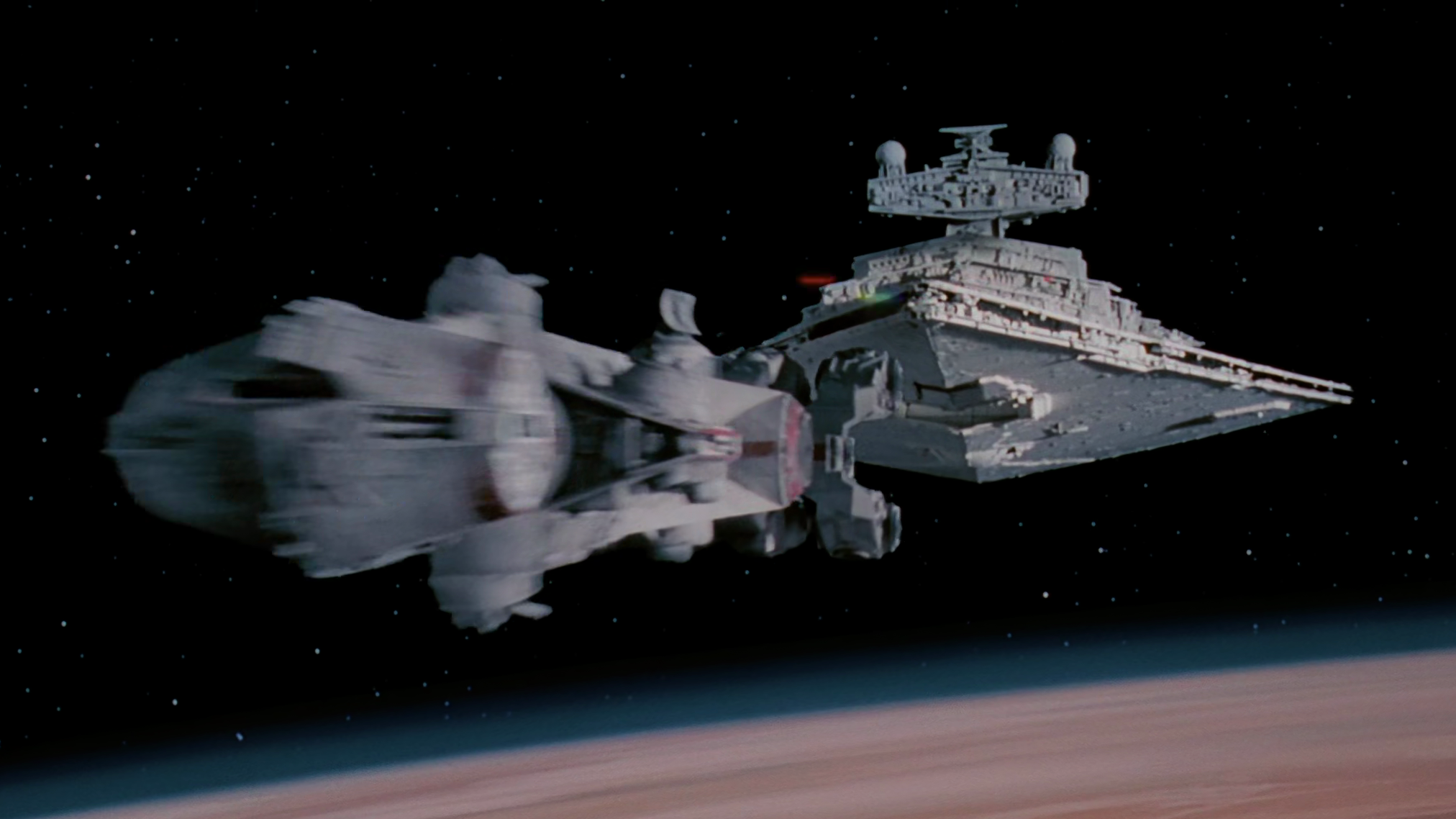
The ship is boarded, and Imperial stormtroopers invade. Following the defeat of the ship's small security force, the Sith Lord Darth Vader arrives to survey the damage. Vader is enraged and interrogates Captain Antilles, ultimately strangling him to death. Concealed on the ship, Princess Leia manages to record a holographic message with the assistance of R2-D2, entrusting the droid with the Death Star plans and the mission to deliver the message to Obi-Wan Kenobi, a Jedi concealed on Tatooine. Stormtroopers discover Leia, stun her, and bring her before Vader. Leia asserts that she and the ship's crew were on a diplomatic mission to Alderaan, but Vader dismisses her claim, labeling her a traitor and imprisoning her. Vader instructs that a message be sent to the Imperial Senate, reporting the ship's destruction and the demise of all aboard. R2-D2 and C-3PO escape in a pod, narrowly avoiding destruction by an Imperial cannon when the operators fail to detect the droids.
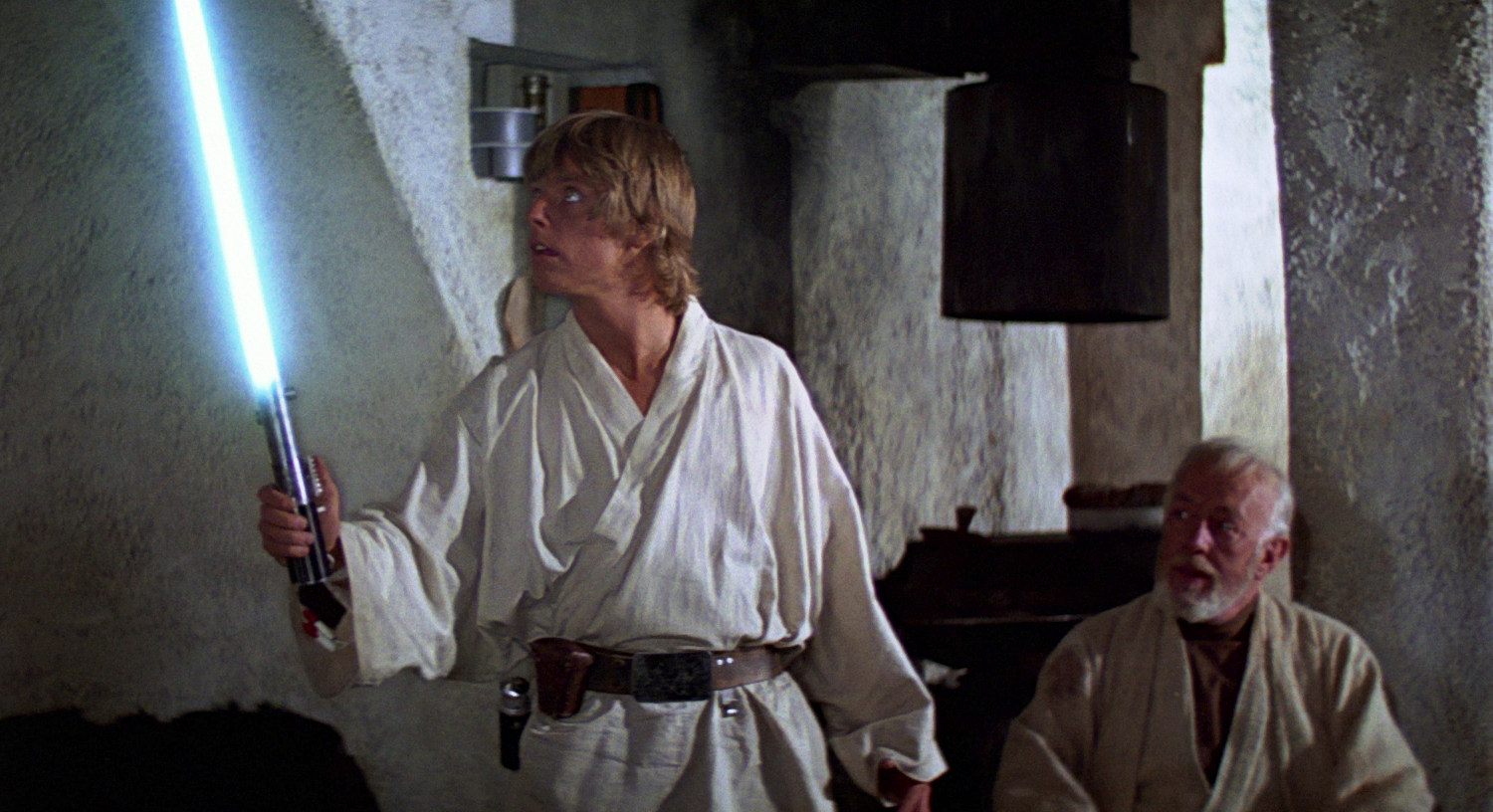
Following a disagreement, the droids are captured by Jawa traders and taken aboard a Sandcrawler. Later, they are purchased by Owen Lars, a moisture farmer, and his nephew, Luke Skywalker, a young man who lost his parents as an infant and dreams of becoming a starfighter pilot. While cleaning R2, Luke discovers a fragment of the hologram and wonders if the mentioned Obi Wan is his neighbor Ben Kenobi.
At dinner with Owen and his Aunt Beru Whitesun Lars, Owen asks Luke to take R2 to Anchorhead to have his memory wiped and hopes Luke will stay for one more harvest season before applying to the Academy. R2 escapes to find Obi-Wan, claiming to be his property. Luke and C-3PO search and find R2, only to be attacked by Sand people. Ben Kenobi rescues them, confirming he is Obi-Wan.
At his home, Obi-Wan gives Luke his father's lightsaber, recalling his friendship with Luke's father. He reveals that they were Jedi before the Empire and that Darth Vader was his apprentice before turning to the dark side of the Force and killing Luke's father. After viewing Princess Leia's full recording, Obi-Wan asks Luke to accompany him to Alderaan. Luke initially refuses but agrees to take Obi-Wan to Anchorhead. They discover the Sandcrawler remains, the Jawas killed by stormtroopers searching for the droids. Luke rushes home to find it burning, his aunt and uncle murdered.
Luke is distraught, but Obi-Wan says he would have been killed too and the plans would be with the Empire. With nothing left on Tatooine, Luke, Obi Wan, and the droids travel to Mos Eisley to find passage to Alderaan.
Aboard the Death Star, Cassio Tagge and Conan Antonio Motti argue about the station's vulnerability and the rebellion's growing support. Wilhuff Tarkin informs them that the Emperor has dissolved the senate. Motti boasts the Death Star's power, but Vader says it is insignificant compared to the Force. When Motti mocks Vader's belief, Vader Force chokes him until Tarkin orders him to stop.
Back in Mos Eisley, Luke, Obi-Wan, and the Droids encounter stormtroopers, but Obi-Wan uses a Jedi Mind trick to pass. At Chalmun's Spaceport Cantina, they hire smuggler Han Solo and his First Mate, Chewbacca, for 17,000 credits to take them to Alderaan aboard the Millennium Falcon. Han has a run-in with Greedo over debts to Jabba The Hutt, which ends with Han shooting Greedo. Jabba confronts Han, who defends his actions and promises to pay. Luke, Ben, and the droids arrive, and after a scuffle, the Falcon escapes and sets course to Alderaan, unaware that the Death Star has arrived there.
Leia, resisting torture for the Rebel Alliance's headquarters, is brought before Grand Moff Tarkin. Tarkin threatens to destroy Leia's Homeworld, Alderaan, if she doesn't reveal the base's location. She reluctantly says it's on Dantooine, but Tarkin destroys Alderaan anyway.
Aboard the Millennium Falcon, Obi-Wan feels a great disturbance in the Force while Luke trains with a training remote. They find an asteroid field where Alderaan should be and are pulled aboard the Death Star by a tractor beam.
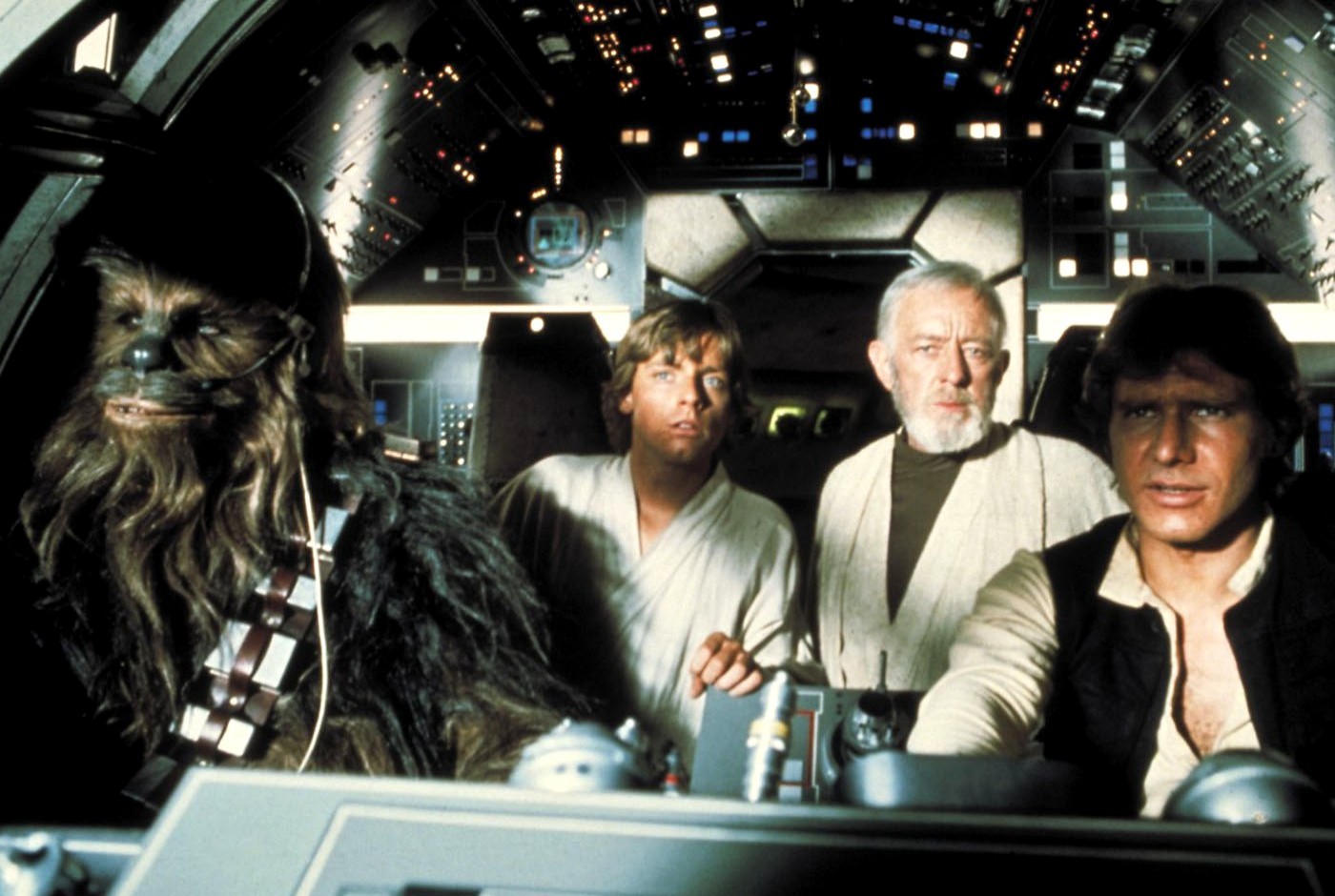
Tarkin and Vader learn Leia lied about the Rebel base. Tarkin orders her execution.
Having docked, Solo and the others ambush stormtroopers and the Imperial scanning crew. Han and Luke, disguised as stormtroopers, storm a control room to escape. Obi-Wan leaves to disable the tractor beam. R2-D2 discovers Leia is scheduled for termination. Luke convinces Han and Chewbacca to rescue her for a reward. Luke plans to enter Detention Block AA-23, claiming Chewbacca is a prisoner transfer. They subdue the officers and guards and free Leia, but are pinned down by stormtroopers. Leia blasts a hole in a grate, and they all jump through.
The chute leads to a garbage compactor with a dianoga. The creature pulls Luke under, but is scared away when the Imperials activate the compactor. As the walls close in, Luke calls C-3PO to shut it down. R2-D2 manages to do so just in time.
After escaping, the group hurries back to the Millennium Falcon. Leia and Han argue about who's in charge. Luke and Leia are separated when Han chases stormtroopers. They swing across a chasm with a Grappling hook, Leia kissing Luke "for luck". The group reunites and heads back to the Falcon.
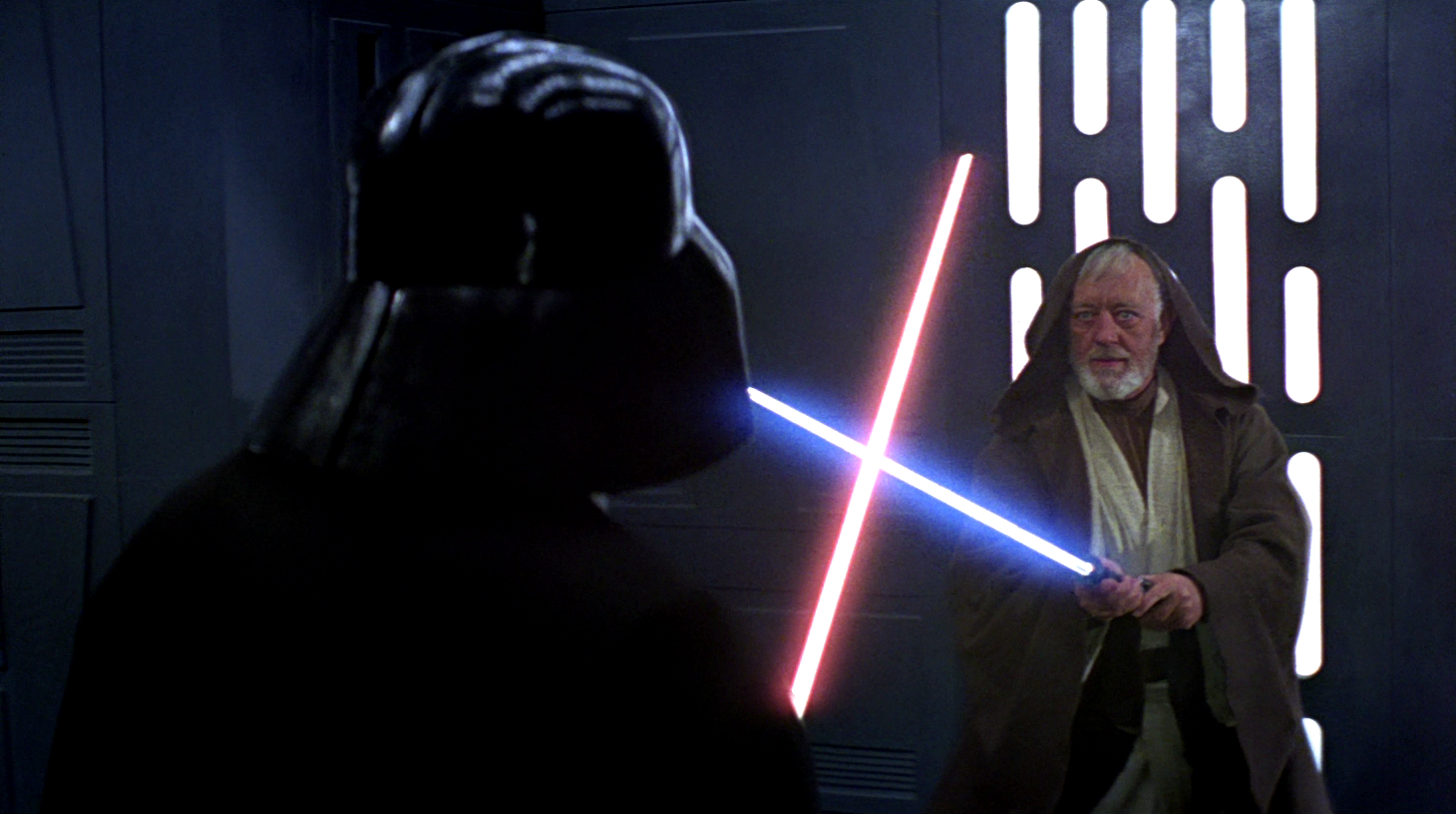
Obi-Wan disables the tractor beam undetected. Vader senses his presence and confronts him in a lightsaber duel. Luke and the others return to the Falcon, witnessing the battle. Obi-Wan allows Vader to strike him down, becoming one with the Force and allowing the others to escape. Luke is horrified and angered, and they flee under fire.
Mourning Obi-Wan's death, Luke helps Solo fend off TIE fighters. Leia believes the Empire let them go to track them to the rebel base. The crew meets the Rebel Alliance on Yavin 4, and R2-D2's information is turned over. General Dodonna plans the attack on the Death Star, revealing a weakness in the form of a thermal exhaust port. He believes a direct hit with Proton torpedos will destroy the station. Han leaves after receiving his reward.
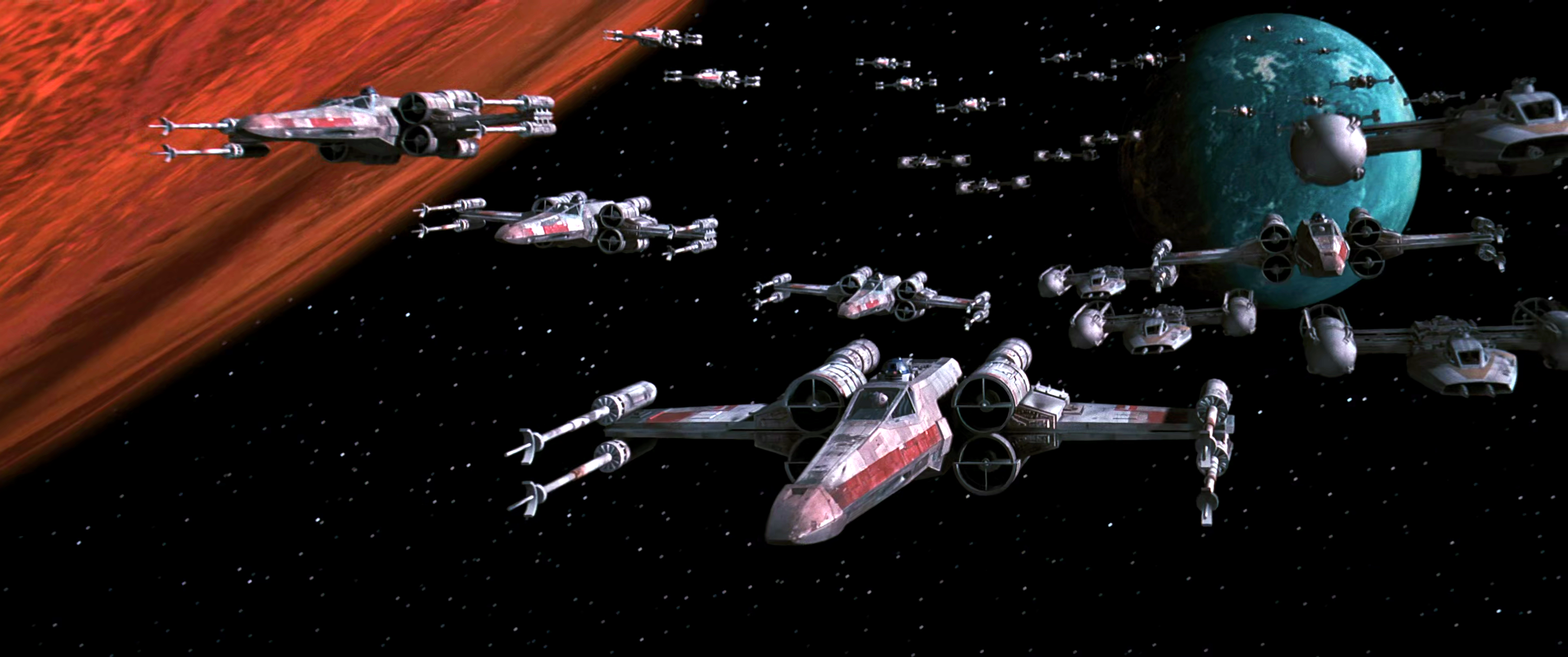
The Rebel strike force attacks the Death Star. X-wing and Y-wing starfighters, including Luke, assault a trench to hit the station's vulnerable spot. Most Rebel craft, including Luke's friend Biggs Darklighter, are destroyed by Imperial fighters led by Darth Vader. Tarkin refuses to evacuate. With the Death Star minutes from destroying Yavin-4, Luke makes a final run down the trench. As Vader fires on Luke, Han returns in the Millennium Falcon and attacks the Imperials, knocking Vader out of the trench. Luke, guided by the Force, fires two proton torpedoes into the exhaust port and retreats. The Death Star explodes, killing Tarkin and everyone on board, while Vader escapes.
The remaining ships return to Yavin 4, and a victory ceremony is held, where medals are presented to Han Solo and Luke Skywalker by Princess Leia.
During post-production on American Graffiti, Lucas frequently discussed a "space opera" with Gary Kurtz. In January 1973, Lucas began this project, creating a 14-page story outline by May for film studios. Originally, he envisioned the film as a continuation of American Graffiti and Apocalypse Now (which he helped develop before Warner Bros. Studios closed his studio, American Zoetrope, forcing him to give development to Francis Ford Coppola). The film's basic plot, a response to the Vietnam War era, involved "a technological empire targeting a small group of freedom fighters." According to Walter Murch, the space opera setting was conceived because audiences wouldn't accept a direct attack on American involvement in Vietnam. Due to its outer space setting, the story was considered science fiction, an unpopular genre. Lucas suggested "space fantasy" or "science fantasy" as better fits. He presented the outline to Universal Studios and United Artists, but both rejected it. He also approached Walt Disney Studios Motion Pictures, who declined. Lucas disliked studio interference due to previous re-editing of his films without his consent. Aware of studios' necessity, he pursued Alan Ladd, Jr., head of 20th Century Fox. Ladd, though not understanding the technical aspects, believed in Lucas's talent. Lucas stated that Ladd "invested in me, [but] he did not invest in the movie."
Lucas wrote several script drafts: a Rough Draft in May, a First Draft in July 1974, a second draft titled Adventures of the Starkiller as taken from the Journal of the Whills, Saga I: The Star Wars in January, and a third titled The Star Wars: From The Adventures of Luke Starkiller in August 1975.
As drafts evolved, characters changed significantly. Luke Skywalker changed from a 60-year-old general to a member of a family of dwarfs. Han Solo was envisioned as a large, green-skinned monster with gills. Chewbacca was inspired by Lucas's dog, Indiana. The Force was initially conceived as the Kyber crystal. The completed script was too long, but Lucas refused to condense it. Instead, he expanded the first third into one movie and left the rest for two future films, creating the original Star Wars trilogy.
Lucas hired Ralph McQuarrie to create paintings of scenes during screenwriting. He included these paintings when delivering the screenplay to 20th Century Fox. They approved a budget of $8,250,000. American Graffiti's success allowed Lucas to renegotiate his deal with Alan Ladd, Jr., requesting sequel rights. This protected Star Wars' unwritten segments and merchandising profits.
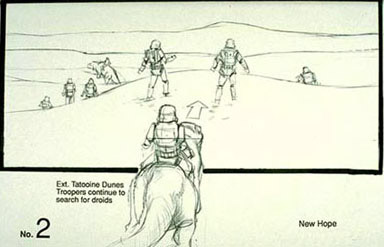
In the year 1975, after he realized that 20th Century Fox had eliminated their visual effects division, George Lucas established the special effects firm known as Industrial Light & Magic (ILM). ILM commenced its work on Star Wars inside a warehouse located in Van Nuys, California. Lucas personally acquired used equipment at very low prices. Traditionally, models were filmed by moving them in front of a stationary camera. A significant portion of the visual effects utilized motion control photography, which gives the impression of grand scale by using small models and cameras that move slowly, known as Dykstraflex. All models were filmed against a blue screen, enabling the integration of other elements into the scene, a technique referred to as optical compositing. The special effects team modified an optical printer, enabling the photographing and combining of separate film strips onto a single film layer. Artists produced matte paintings to enhance the scope and production quality of scenes by expanding environments painted on glass, which were then photographed and merged with live-action footage. Model spaceships were built based on drawings from Joe Johnston, contributions from Lucas, and paintings created by McQuarrie. Lucas chose to move away from the typical sleekness found in science fiction, instead creating a "used universe" where all equipment, ships, and structures appeared worn and dirty. Principal photography began on March 22, 1976 in Tunisia. Lucas experienced delays during the initial week of filming due to an unusual rainstorm in Tunisia, malfunctioning props, and electronic failures. During Anthony Daniels' initial time wearing the C-3PO costume, the left leg section broke, piercing through the plastic and stabbing his left foot. After completing filming in Tunisia, the production relocated to the more controlled setting of Elstree Studios, situated near London. Nevertheless, considerable issues, including a crew with limited enthusiasm for the project, persisted. The majority of the crew regarded the film as a "children's film," rarely taking their work seriously and often finding it unintentionally amusing. Kenny Baker later admitted that he believed the film would fail. Harrison Ford struggled with the dialogue, commenting, "You can type this shit, George, but you sure can't say it." Lucas had disagreements with Director of Photography Gilbert Taylor, whom producer Gary Kurtz described as "old-school" and "crotchety." Furthermore, with his background in independent filmmaking, Lucas was used to creating most of the film's elements himself. His camera suggestions were dismissed by an offended Taylor, who felt that Lucas was overstepping his boundaries by giving specific instructions. Lucas eventually grew frustrated that the costumes, sets, and other elements were not aligning with his original vision for Star Wars. He rarely engaged with the actors, who felt he expected too much of them while providing minimal direction. His directions to the actors usually consisted of the words "faster" and "more intense." Ladd offered Lucas some of the only support from the studio; he dealt with scrutiny from board members over the rising budget and complex screenplay drafts. After production fell two weeks behind schedule, Ladd told Lucas that he had to finish production within a week or he would be forced to shut down production. The crew split into three units, led by Lucas, Kurtz, and production supervisor Robert Watts, respectively. Under the new system, the project met the studio's deadline. ILM concluded shooting on April 22, 1977 with shot 110P, that of a Star Destroyer. Star Wars was originally slated for release in Christmas 1976; however, delays pushed the film's release to summer 1977. Already anxious about meeting his deadline, Lucas was shocked when his editor's first cut of the film was a "complete disaster." After attempting to persuade the original editor to cut the film his way, Lucas replaced the editor with Paul Hirsch and Richard Chew. He also allowed his then-wife Marcia Lucas to aid the editing process while she was cutting the film New York, New York with Lucas' friend Martin Scorsese. Richard Chew found the film had an non-energetic pace; it had been cut in a by-the-book manner: scenes were played out in master shots that flowed into close-up coverage. He found that the pace was dictated by the actors instead of the cuts. Hirsch and Chew worked on two reels simultaneously; whoever finished first moved on to the next. During production, the cast attempted to make Lucas laugh or smile as he often appeared depressed. At one point, the project became so demanding that Lucas was diagnosed with hypertension and exhaustion and was warned to reduce his stress level. Post-production was equally stressful due to increasing pressure from 20th Century Fox. Moreover, Mark Hamill's face was injured in a car accident, which made reshoots impossible. Meanwhile, ILM was struggling to achieve unprecedented special effects. The company had spent half of its budget on four shots that Lucas deemed unacceptable. Moreover, theories surfaced that the workers at ILM lacked discipline, forcing Lucas to intervene frequently to ensure that they were on schedule. With hundreds of uncompleted shots remaining, ILM was forced to finish a year's work in six months. Lucas inspired ILM by editing together aerial dogfights from old war films, which enhanced the pacing of the scenes. During the chaos of production and post-production, the team made decisions about character voicing and sound effects. Sound designer Ben Burtt had created a library of sounds that Lucas referred to as an "organic soundtrack." For Chewbacca's growls, Burtt recorded and combined sounds made by dogs, bears, lions, tigers, and walruses to create phrases and sentences. Burtt created the robotic voice of R2-D2 by filtering his voice through an electronic synthesizer. Darth Vader's breathing was achieved by Burtt breathing through the mask of a scuba tank implanted with a microphone. Lucas never intended to use the voice of David Prowse, who portrayed Darth Vader in costume, because of Prowse's thick English West Country accent. He originally wanted Orson Welles to speak for Darth Vader. However, he felt that Welles' voice would be too recognizable, so he cast the lesser-known James Earl Jones. Nor did Lucas intend to use Anthony Daniels' voice for C-3PO. Thirty well-established voice actors, such as Stan Freberg, read for the voice of the droid. According to Daniels, one of the major voice actors recommended Daniels' voice for the role. The "Lost Cut" of Star Wars was edited by John Jympson. When Lucas screened an early cut of the film for his friends, among them directors Brian De Palma, John Milius and Steven Spielberg, their reactions were disappointing. Spielberg, who claimed to have been the only person in the audience to have enjoyed the film, believed that the lack of enthusiasm was due to the absence of finished special effects. Lucas later said that the group was honest and seemed bemused by the film. In contrast, Alan Ladd, Jr. and the rest of 20th Century Fox loved the film; one of the executives, Gareth Wigan, told Lucas, "This is the greatest film I've ever seen," and cried during the screening. Lucas found the experience shocking and rewarding, having never gained any approval from studio executives before. Although the delays increased the budget from $8 million to $11 million, the film was still the least expensive of the Star Wars saga.
From the very beginning, Lucas' intention for "Star Wars" was that it would have very familiar sounding music, that despite the extraordinary visuals and events occurring onscreen, the music would be reminiscent of Earth and of the past. To that end, he originally wanted to fill the film with tracked classical music from various composers, in a similar fashion to 2001: A Space Odyssey. Lucas' friend, Steven Spielberg, recommended composer John Williams to Lucas after their recent collaboration on Jaws (1975). Spielberg convinced Lucas that he should meet with the composer, who in turn convinced him of the need for original music. They also decided in this early meeting that the score should have a romantic musical sound, with leitmotifs for different characters and events, similar to the operas of Richard Wagner. Rough cuts of "Star Wars" used something called a "temp score", referring to musical material that was there to find a rhythm while editing but would not be kept in the final cut as it would be replaced by the final score. These temp tracks would help to inspire the direction John Williams was to take with his score as he began writing it. Most of the temp tracks are not public knowledge, but some information has been revealed over the years. In one interview, editor Paul Hirsch confirmed that a cue from Bernard Herrmann's Psycho score containing the famous "3-note motif" was used to temp the scene where the heroes exit the smuggling chambers of the Millennium Falcon. In another interview, Hirsch revealed that the opening to "The Sacrifice" from Igor Stravinsky's "The Rite of Spring" was used to temp the scene in the desert, the Jawa scenes were temped from other parts of the same piece, and the Main Title crawl was temped with the overture of Ivanhoe by Miklós Rózsa. Later, in his own book, Hirsch would claim that the Main Title crawl was temped with Erich Korngold's theme to the 1938 Robin Hood. It is unknown which of these claims is correct. Also in his book, Hirsch mentions that the Cantina scene was tracked by Benny Goodman's "Avalon" from his Carnegie Hall performance, some of the early battle footage was tracked with "Dance of the Adolescents" from "The Rite of Spring", and the approach to the Death Star was temped with the music from the approach to Kong Island from Max Steiner's King Kong score. In an interview, sound editor Ben Burtt said that Antonín Dvořák's New World Symphony was temped into the medal ceremony (Hirsch mentioned this in his book too), and parts of Anton Bruckner's Ninth Symphony were temped as Luke's theme. Homages to many of these known temp tracks appear in the final score. For example, the cue [1m5-2m1] Desert Song from Star Wars is extremely similar to the opening of the Stravinsky piece it was temped with. Further, the music in [1m2] Main Title that plays when the underbelly of the Star Destroyer flies over the camera is very similar to the ending of "Mars - The Bringer of War" from Holsts' "The Planets". Even the 3-note motif from Psycho appears in the very opening of the Star Wars cue [7m1-7m2 New] The Hatch Opens, exactly where the temp track would have been. On January 10th, 1977, Williams was invited to the spotting sessions, where he watched a rough cut of the film with Lucas, music supervisor Lionel Newman, music editor Ken Wannberg, producer Gary Kurtz, and film editor Paul Hirsch. Over the next several weeks, he would get to work writing the score. The way Williams wrote his score, he began by creating all the various leitmotifs and character themes (such as "Luke's Theme," "Leia's theme," and "Ben's theme," the "Jawa theme," the "Rebel Fanfare," and the "Imperial motif"). He then went on to create the actual score by stringing all the themes he created together in a way that would match up with what was happening on screen. It's unknown exactly how long John Williams spent writing the score, but it is certain that he would have had at the absolute most no more than 8 weeks, given that they started recording on March 5th. This is unrealistic because there needed to have been time for the orchestrators to write out all the various parts for the players, so it is more likely that the score was completed in 7 weeks or less. As with any creative process, parts of the score went through multiple revisions. One well-known example is the cue "Lost R2", which scores the famous "binary sunset" scene. This scene was originally scored with a very different sounding piece that contained "Luke's theme". When Lucas heard the cue, he asked if it could be rescored with "Ben's theme" because he felt it fit the scene better. It can be argued that this opened the door for "Ben's theme" to be recontextualized into what we think of today as the "Force theme". Another interesting example of the score changing was the cue "A Home Destroyed". When this cue was written, it was designed to score the end of Ben's house, Leia's torture, the discovery of the attacked sandcrawler, and Luke returning home to find his guardians dead and his home burned. While Williams was writing the score, the film was re-edited so that the board room scene would occur where the torture scene used to be. This caused the cue to be split in half. The first 14 bars were recorded by themselves with a newly written ending featuring the "Death Star theme" for the transition to the boardroom scene. Then a second cue was recorded, being made up of bars 31-71 (attacked sandcrawler and burned homestead scenes) and bars 17-30 (Leia torture scene), with some new transition material written to join them. This isn't the only time editing of the film would require changes to the score, but it is one of the only examples where a re-edit resulted in the score being changed before it was recorded. The rest of the edits were done too late, and the remaining score changes were left to be made artificially by Ken Wannberg. After the writing of the score was completed, the orchestrations were performed by lead orchestrator Herbert Spencer, who was assisted by Arthur Morton, Angela Morley, Al Woodbury, Alexander Courage and Williams himself.
When it came time to record the score, Williams was given no choice but to record in London, presumably due to budget constraints and the fact that most of the film was shot in England. He did have the choice of which orchestra he wanted to work with, and he ended up choosing the London Symphony Orchestra (LSO) due to its primary conductor being his friend André Previn. This was historically significant, as it was the first time Williams ever got to work with an organized symphony orchestra for a film. Previous films of his usually recorded with freelance players. The score was recorded over the course of eight days between March 5th and March 16th of 1977 at Anvil Recording Studios in Denham, England. People present at the sessions included John Williams himself, who was conducting, George Lucas, recording engineer Eric Tomlinson, his assistant Alan Snelling, and music editor Ken Wannberg. The orchestra itself was made up of 26 violins, 10 violas, 10 cellos, 6 basses, 11 woodwinds, 8 horns, 4 trumpets, 3 trombones, 2 tubas, 2 harps, 3 percussion, 1 timpani, 1 piano, and 1 celeste. The score was recorded with approximately 23 microphones, placed at strategic positions around the orchestra. The mixing console, a Rupert Neve, had 24 inputs and 16 outputs. Recording engineer Eric Tomlinson used the console to create a live LCR (Left, Center, Right) mix while the orchestra was playing. The live mixes were recorded straight to two 35mm magnetic film recorders (with healthy Dolby A noise reduction applied). The live mix was also routed to tracks 1-3 of a Struder A80 16-track 2 inch recorder, with sections of the orchestra isolated on tracks 4-15 and a 50 hz pilot tone on track 16. The pilot tone could later be used for synchronization with the film during editing. After the recording was completed, the best takes were combined into performance edits by music editor Ken Wannberg. He created performance edits using one of the 35mm mag recordings, as well as with the 16 track tapes. (note: a performance edit is where sections of different takes are combined together to create the best possible recording of a given cue) The 16 track tapes were intended both for backup purposes, and to be sent off to be remixed by John Neal for the eventual soundtrack release on LP. The 35mm edits would of course be further edited by Wannberg into the final stems for use in the film.
The score to Star Wars has had several releases over the years. While many of these releases have been straight reissues of previous releases, there are currently four releases with unique programs that were independently mastered from the original session tapes:
A New Hope initially was shown with monaural sound in many theaters, although the initial 70mm prints represented some early instances of surround sound for a wide release—something not seen commercially since the Cinerama and Cinemascope experiments of the early 1950s.
The movie incorporated ideas from various sources. George Lucas has confirmed this conscious decision in interviews. It is typical of much myth-building. Lucas has mentioned that Akira Kurosawa's 1958 film The Hidden Fortress (USA release 1962) exerted a significant influence. The similarity between the two comical farmers in The Hidden Fortress and the two talkative droids in A New Hope is clear. In fact, when the droids are alone on Tatooine, the music and "wipe" cuts are a direct homage to Hidden Fortress. When Motti criticizes Darth Vader, he is about to mention the Rebels' "hidden fortress" before Vader interrupts him. The final scene where the Death Star is attacked was patterned after (including similar dialogue) the 1950s movie The Dam Busters, where RAF Lancaster bombers fly along heavily defended reservoirs and aim "bouncing bombs" at German man-made dams to cripple the heavy industry of the Ruhr. (A New Hope cinematographer Gilbert Taylor had previously contributed to the special-effects sequences for that film.) Lucas has referenced the film 633 Squadron directed by Walter Grauman when citing movies that inspired themes or elements in A New Hope. The "trench run" in A New Hope wherein Luke flies his X-wing through a "trench" on the Death Star and destroys the ship was inspired, at least in small part, by the finale of 633 Squadron, which involves several Royal Air Force planes flying at low level up a fjord against heavy, ground-based anti-aircraft fire, to attack a factory located at the base of a cliff at the canyon's end.
Concerned that Star Wars would be overshadowed by other summer releases, like Smokey and the Bandit, 20th Century Fox moved the premiere to the Wednesday before Memorial Day: May 25, 1977. However, few theaters ordered the film to be shown. In response, 20th Century Fox demanded that theaters order Star Wars if they wanted an eagerly anticipated film based on a best-selling novel titled The Other Side of Midnight. The New York Times published the first advertisements for the film on May 15, only ten days before its premiere. Star Wars achieved immediate success upon its release; within three weeks, 20th Century Fox's stock value doubled to a record high. Before 1977, 20th Century Fox's largest annual profits were $37,000,000; in 1977, the company earned $79,000,000. Although the film's cultural neutrality helped it to gain international success, Ladd became anxious during the premiere in Japan. Following the screening, the audience remained silent, causing Ladd, Jr. to worry about the film's potential failure. He later learned that silence in Japan is the greatest honor one can give to a film. Concurrently, thousands attended a ceremony at Grauman's Chinese Theater, where C-3PO, R2-D2, and Darth Vader left their footprints in the theater's forecourt. During the film's original theatrical run, there were a number of television promotions:
- Darth Vader on The Wacko Saturday Morning Preview and Other Good Stuff Special (September 8, 1977)
- Darth Vader on The ABC All-Star Saturday preview show (September 9, 1977) [51]
- A re-creation of the cantina set for The Richard Pryor Show (September 13, 1977)
- The Making of Star Wars TV special (September 16, 1977)
- A Star Wars –themed Donnie and Marie episode (September 23, 1977)
- Mark Hamill on The Bob Hope All Star Christmas Comedy Special (December 19, 1977)
- Bill Murray's " Nick The Lounge Singer " singing the Star Wars Main Theme on Saturday Night Live (January 28, 1978)
- The Star Wars Holiday Special (November 17, 1978) [52]
- Carrie Fisher on Saturday Night Live (November 18, 1978)
- American Graffitti 's Wolfman Jack interviews Darth Vader on The Midnight Special . (unknown date) [53]
Charles Lippincott was employed as marketing director for Star Wars by Lucas' production company, Lucasfilm Ltd.. Given 20th Century Fox's limited marketing support beyond licensing T-shirts and posters, Lippincott had to seek opportunities elsewhere. He successfully negotiated deals with Stan Lee, Roy Thomas, and Marvel Comics for a comic book adaptation, as well as with Del Rey Books for a novelization. Although Star Wars merchandise was accessible to eager children upon release, only Kenner Toys—who were skeptical about the film's success—had accepted Lippincott's licensing offers. Kenner addressed the sudden demand for toys by selling boxed vouchers in its "empty box" Christmas campaign; these vouchers could be exchanged for the toys in March 1978. The novelization of the film was published in December 1976, six months before the film was released. Although George Lucas was credited as the author, it was later revealed that Alan Dean Foster ghostwrote the book. Foster also went on to write the first Expanded Universe novel, Splinter of the Mind's Eye. The book was initially published as Star Wars: From the Adventures of Luke Skywalker; later editions were simply titled Star Wars, and subsequently Star Wars Episode IV: A New Hope, to reflect the film's retitling. Certain scenes that were cut from the film (and later restored or archived in DVD bonus features) were included in the novel, such as Luke at Tosche Station with Biggs and the encounter between Han and Jabba in Docking Bay 94. Other deleted scenes from the movie, such as a close-up of a stormtrooper riding on a Dewback, were included in a photo insert added to later printings of the book. Smaller details were also altered; for example, Luke's callsign during the Death Star assault is Blue Five instead of Red Five as it is in the film. Lippincott finalized the agreement with Del Rey Books to publish the novelization in November 1976. By February 1977, half a million copies had been sold. A radio drama adaptation of the film was written by Brian Daley, directed by John Madden, and produced for and broadcast on the American National Public Radio network in 1981. George Lucas cooperated with the adaptation, donating the rights to NPR. John Williams' music and Ben Burtt's sound design were retained for the show; Mark Hamill (Luke Skywalker) and Anthony Daniels (C-3PO) also reprised their roles. The radio drama presented scenes not included in the final film cut, such as Luke Skywalker observing the space battle above Tatooine through binoculars, a skyhopper race, and Darth Vader's interrogation of Princess Leia. In terms of Star Wars canon, the radio drama is regarded with the highest designation, G-canon. Over the
Several comic book versions of the movie have been created over the years:
- Marvel Comics began their Star Wars comic series by adapting the film into six parts; Roy Thomas wrote the adaptation, and Howard Chaykin provided the illustrations.
- In 1978, Al Williamson created a comic strip adaptation, but it was never made available to the public.
- Dark Horse Comics put out a new four-part adaptation to coincide with the 1997 Special Edition release; Bruce Jones was the writer, and Eduardo Barreto was the illustrator.
- A manga adaptation illustrated by Hisao Tamaki was published in Japan in 1997, followed by a United States release in 1998.
Initially, the movie was simply known as Star Wars, without the Episode IV designation or the subtitle A New Hope. The episode number and subtitle were introduced in the opening crawl of the 1980 sequel, Star Wars: Episode V The Empire Strikes Back. When the original film was re-released on April 10, 1981, the title Episode IV: A New Hope was added above the original opening crawl. Lucas has stated that he only ever planned for six films. However, early interviews with Lucasfilm representatives included discussions about the possibility of nine or even twelve films. The film was shown in theaters again in 1978, 1979, 1981, 1982, and 1997.
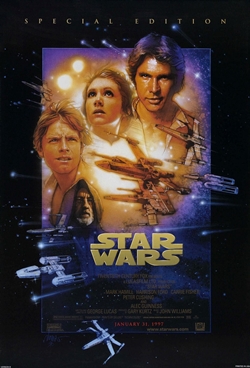
After Steven Spielberg's Jurassic Park utilized computer generated effects from ILM, Lucas decided that digital technology had advanced enough to realize his original vision for Star Wars. To celebrate the 20th anniversary of Star Wars in 1997, A New Hope underwent digital remastering and was re-released in theaters. This re-release was part of a campaign called The Star Wars Trilogy: Special Edition, which also included The Empire Strikes Back and Return of the Jedi. The Special Edition versions included visual shots and scenes that were impossible to create during the original release due to limitations in budget, technology, and time. One example is a scene featuring a meeting between Han Solo and Jabba the Hutt. While most of the changes were minor or cosmetic, some fans felt that Lucas diminished the film with these additions. One controversial alteration involved Greedo shooting first during his confrontation with Han Solo, which has inspired "Han shot first" T-shirts.
A New Hope was made available on DVD on September 21, 2004 as part of a box set that included The Empire Strikes Back, Return of the Jedi, and a bonus disc with extra content. The movies were digitally restored and remastered, and George Lucas implemented additional changes.
The DVD includes a commentary track featuring George Lucas, Ben Burtt, Dennis Muren, and Carrie Fisher. The bonus disc contains the documentary Empire of Dreams: The Story of the Star Wars Trilogy, three featurettes, teaser and theatrical trailers, TV spots, still galleries, an exclusive preview of Star Wars: Episode III Revenge of the Sith, a playable Xbox demo of the LucasArts game Star Wars: Battlefront, and a "Making Of" documentary about the Episode III video game. This set was re-released in December 2005 as a three-disc "limited edition" boxed set, but without the bonus disc.
The trilogy was re-released as separate two-disc Limited Edition DVD sets from September 12, 2006, to December 31, 2006. These sets included the original versions of the films as bonus material. This release, often called "George's original unaltered trilogy," or "GOUT," was met with controversy because the "unaltered" versions were sourced from the 1993 non-anamorphic laserdisc masters and were not re-transferred to current DVD standards.
The Blu-ray version was released on September 16, 2011.
On April 7, 2015, the digital releases of the six released Star Wars films were jointly announced by the Walt Disney Studios, 20th Century Fox, and Lucasfilm. A New Hope was released for digital download by Fox on April 10, 2015, while Disney released the other five films.
Even after The Walt Disney Company's 2012 acquisition of Lucasfilm and the release rights to all future Star Wars movies, Fox was to keep the original distribution rights to A New Hope in perpetuity across all media worldwide, as they had co-produced and co-financed it. Fox was also to retain worldwide theatrical, nontheatrical, and home video rights to the franchise's five subsequent films, which Lucasfilm had independently produced and financed, until May 2020, when ownership would transfer to Disney. This complicated relationship between Fox and Disney, especially regarding Fox's permanent rights to Episode IV, presented a challenge for any future boxed set containing all nine films. On December 14, 2017, The Walt Disney Company announced its acquisition of most of Fox's parent company, 21st Century Fox, which included the film studio and all distribution rights to A New Hope. The deal was officially finalized on March 20, 2019. On April 12, 2019, it was reported that a Blu-ray box set containing all nine main installments of the Star Wars saga, remastered in 4K, was in development for release in 2020.
Star Wars premiered on May 25, 1977, in 32 theaters and quickly broke attendance records, becoming one of the first blockbuster films. It remains one of the most commercially successful movies ever made. Cast and crew members recalled seeing long lines of people wrapped around theaters. Even technical crew members, such as model makers, were asked for autographs, and the actors became instantly famous. The film's initial U.S. gross was $307,263,857, and it earned $6,806,951 during its first weekend of wide release. Lucas said he spent most of the release day in a sound studio in Los Angeles. When he and his then-wife Marcia went out for lunch, they noticed a long line of people waiting to see Star Wars outside Mann's Chinese Theater. The film was the highest-grossing film of 1977 and held the record for the highest-grossing film of all time until E.T. The Extra-Terrestrial surpassed it in 1982. (With subsequent re-releases, Star Wars regained the title, but later lost it to James Cameron's 1997 hit Titanic.) The film grossed $797,900,000 worldwide, becoming the first film to reach the $300 million mark. When adjusted for inflation, it is the second highest-grossing movie of all time in the United States, second only to Gone with the Wind.
In 1989, the U.S. National Film Registry of the Library of Congress selected the film as one that is "culturally, historically, or aesthetically important." In 2006, Lucas's original screenplay was ranked as the 68th greatest of all time by the Writers Guild of America. The American Film Institute (AFI) placed it 15th on its list of the top 100 films of the 20th century. The AFI has recognized Star Wars and its specific elements in several of its "top 100 lists" of American cinema, which were compiled as part of the Institute's 100th-anniversary celebration. These include its ranking as the 27th most thrilling American film of all time, the 39th most inspirational American film of all time, Han Solo as the 14th greatest American film hero of all time, and Obi-Wan Kenobi as 37th on the same list. The frequently quoted line "May the Force be with you" was ranked as the eighth greatest quote in American film history. John Williams's score was recognized as the greatest American film score of all time.
Star Wars received numerous awards at the 1978 Academy Awards, including Best Art Direction-Set Decoration, which was awarded to John Barry, Norman Reynolds, Leslie Dilley, and Roger Christian. Best Costume Design was given to John Mollo. Paul Hirsch, Marcia Lucas, and Richard Chew won Best Film Editing. John Stears, John Dykstra, Richard Edlund, Grant McCune, and Robert Blalack received awards for Best Effects, Visual Effects. John Williams won his third Oscar for Best Music, Original Score. Best Sound went to Don MacDougall, Ray West, Bob Minkler, and Derek Ball. Ben Burtt received a Special Achievement for sound effects. Other nominations included Alec Guinness for Best Actor in a Supporting Role, George Lucas for Best Screenplay and Best Director, and Gary Kurtz for his producing role in Best Picture. At the Golden Globe awards, the film received nominations for Best Motion Picture - Drama, Best Director, Best Supporting Actor (Alec Guinness), and Best Score, but only won the award for Best Score. It earned six BAFTA nominations: Best Film, Best Editing, Best Costume, Best Production/Art Design, Best Sound, and Best Score, winning in the latter two categories. John Williams's soundtrack album won the Grammy award for Best Album of an original score for a motion picture or television program, and the film was awarded the Hugo Award for Best Dramatic Presentation. In 1997, Chewbacca was honored with the lifetime achievement award at the MTV Movie Awards for his contributions to the Star Wars trilogy.
If the film had not performed well at the box office, Lucas had planned to adapt the novel Splinter of the Mind's Eye into a low-budget sequel. According to an interview with Alan Dean Foster in Empire magazine, the book was intended to be filmed as a low-budget sequel if Star Wars did not achieve significant success. Harrison Ford was not contracted for the sequel at the time of writing the book, which explains Han Solo's absence from the novel. However, the success of A New Hope allowed Lucas to proceed with The Empire Strikes Back.
Throughout Star Wars, there are several brief alternate takes where Luke is wearing his poncho. These scenes include Luke in the desert, in the Tusken Raiders' canyon, Luke discovering the destroyed homestead, and in the hangar on Yavin 4. The only poncho scenes that made it into the final cut were in Docking Bay 94, during the Millennium Falcon's flight from the Death Star, and upon arriving on Yavin 4.
Beru is shown in the homestead, pouring a blue liquid into a jug.
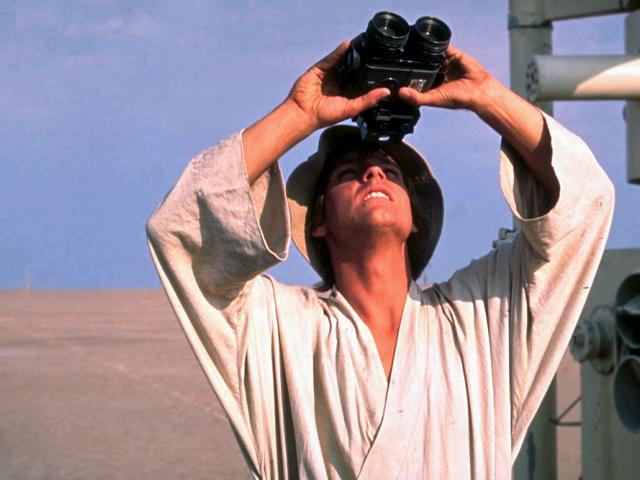
Luke Skywalker is depicted in the Tatooine desert, repairing a moisture vaporator with the help of a Treadwell droid, when he notices bright objects in the sky. Using his macrobinoculars, Luke observes two ships engaged in combat beyond the atmosphere. He then gets into his landspeeder. The Treadwell malfunctions, blowing a fuse and preventing it from following. Luke speeds off into the desert to find his friends. This scene was originally placed after the Tantive IV is boarded and before Darth Vader's initial appearance in the film. Unfortunately, clear footage of this scene is no longer available due to degradation from poor film storage. Before being cut, this scene served as the audience's first introduction to Luke Skywalker, much earlier than in the final version. It was removed along with subsequent scenes featuring Luke and his friends in Anchorhead. George Lucas initially wrote and shot these scenes because his industry friends believed that audiences would struggle to understand a story told solely from a droid's perspective. However, after realizing that the story was primarily about the droids' adventures and their role in leading events to Luke and Obi-Wan, Lucas decided to remove the footage.
Luke's landspeeder speeds into Anchorhead, nearly hitting an elderly woman. He excitedly enters Tosche Station, telling his friends about the battle he witnessed above the planet. He is thrilled to see his friend Biggs Darklighter, who is on leave from the Academy. Deak, Windy, Camie, Fixer, and Biggs follow Luke outside to observe the battle through his macrobinoculars. As the battle appears to have ended, Luke's friends mock him for exaggerating. This scene was intended to follow R2-D2 and C-3PO ejecting from the Tantive IV in an escape pod and precede the scene where Princess Leia is taken captive before Darth Vader. The scene establishes Luke's challenging relationships with his peers and provides insight into life on Tatooine. While storyline pacing may have been a factor in its removal, it's also worth noting that after Lucas's initial screening of the rough cut of Star Wars in 1977, a fellow filmmaker jokingly accused him of making "American Graffiti in space." This comment likely influenced Lucas to cut the scenes set in Anchorhead. The sequence where Luke nearly runs down an old woman was an unfinished effects shot.
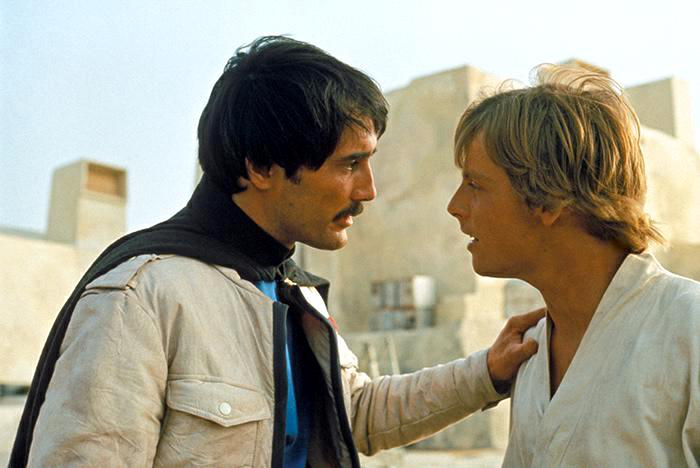
This scene features a conversation between Luke and his close friend, Biggs Darklighter. Biggs has left Tatooine and is on leave from the Imperial Academy, where he is training to be a space pilot. Luke's envy of Biggs's success clashes with his responsibilities to his uncle and his reasons for staying on Tatooine. Biggs confides in Luke that he plans to join the Rebellion against the Empire. In an emotional and tense exchange, the two young men say their final goodbyes. This scene was to be placed between the scene where C-3PO spots a distant Jawa sandcrawler in the desert and the capture of R2-D2 by the Jawas in the canyon. The Luke and Biggs sequence was part of the larger Anchorhead backstory on Tatooine and was cut along with the other early scenes on Tatooine, likely to improve the story's pacing.
In this brief scene, Darth Vader and Chief Bast are walking along a corridor on the Death Star. Bast reports that the search for the missing droids has extended to Mos Eisley spaceport. Vader notes that Princess Leia is resisting interrogation, and Bast boldly criticizes Tarkin's plan to break her as "foolish." The scene would have been placed between the scene where Han Solo encounters Jabba the Hutt in Docking Bay 94 (also cut) and the scene where Luke and Ben find the Millennium Falcon in Docking Bay 94.
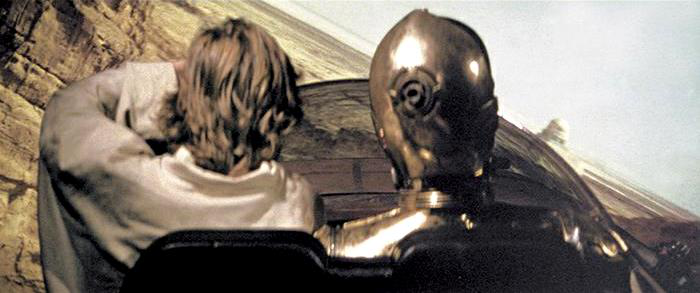
R2-D2 has run away from his new master, Luke Skywalker. Early in the morning, Luke and Threepio hurry off in the landspeeder to find R2, with Threepio driving. They discuss Artoo, Ben Kenobi, and Uncle Owen's likely anger. The scene would have been placed at the beginning of the sequence where Luke and 3PO search for R2, before the attack by the Tusken Raiders. The moment was scored with a lighter version of Luke's theme; the music can be heard at the start of the cue "Land of the Sand People" on the original LP and CD configurations, or "Landspeeder Search" in the Special Edition album. Before the advent of CGI, scenes like this landspeeder cockpit sequence had to be filmed against a rear-projection screen. The scene was removed due to its poor quality.
This scene features Darth Vader and another Imperial officer on the Death Star.